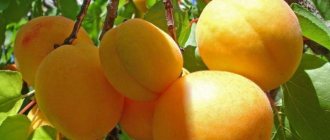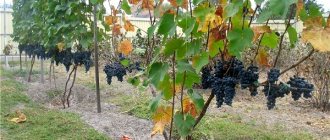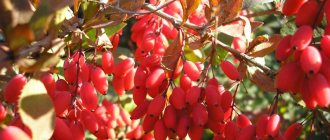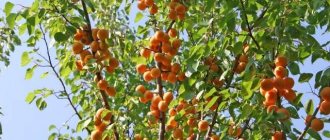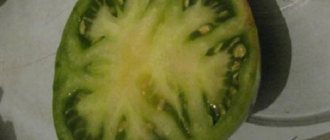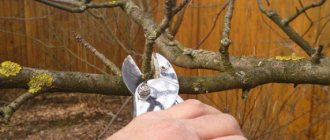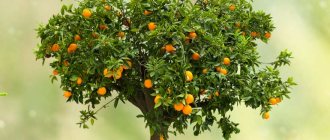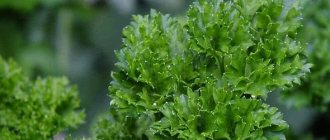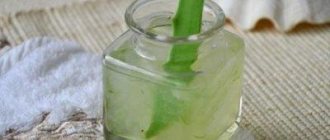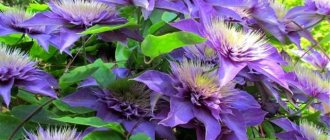Description and history of variety selection
This hybrid grows up to 4–5 m in height and has a spreading, wide, lush crown. The trunk is covered with gray wood with sinuous longitudinal recesses. The foliage is large, rough, bright green.
Did you know? In the USA there is National Apricot Day. It is celebrated on January 9.
The fruits are quite large - 30–50 g; the weight is influenced by growing and growing conditions. The skin of apricots is velvety, yellowish, and has reddish specks. The pulp is moderately dense, juicy, creamy in color. The bone separates well. The taste of the fruit is sweet, slightly sour, without cloying. A distinctive feature is the characteristic smell of pineapple.
Apricot Pineapple is a hybrid of Armenian selection and has another name - Shalah . Some sources note that the variety was obtained in Crimea, on the territory of the State Nikitsky Botanical Garden. However, for many gardeners this is not significant.
Breeders successfully use the positive characteristics of the variety when breeding updated hybrids. Thus, close varieties of apricot Shalah are:
- Pineapple columnar . Grows no higher than 2.5 m. Compact, can be cultivated in a tub. Fruits well and abundantly. The ovaries form directly on the central trunk.
- Pineapple Tsyurupinsky. It was bred in Ukraine, in the Kherson region, but in some respects (low immunity) it is inferior to Shalakh. Main disadvantages: small fruits, fall off, depend on the environment, low yield, short productive period - 25 years.
Did you know? According to historical sources, apricot was brought to Europe from the East by Alexander the Great.
Characteristics of the variety
The Pineapple apricot has many fans due to its excellent characteristics . And every year there are more and more gardeners who prefer to grow this crop.
Resistance to diseases and pests
The culture has high immunity to fungal diseases. The tree is resistant to moniliosis, hole spotting and leaf curl.
Drought resistance and winter hardiness
Like all apricots, the Pineapple variety does not tolerate severe and prolonged frosts. According to the degree of frost resistance, the hybrid is given an average score (up to -25...-27°C). With these indicators, fruiting and the condition of the trees do not suffer. But only on the condition that the cold does not last long.
Reviews from gardeners about apricot Pineapple
I made compote and jam from Pineapple. I can say that I have never eaten or cooked such apricot preparations before or since. In the jam, it’s not that the slices were boiled, they all remained intact and even seemed to have become wilted. In this case, the jam was boiled, and not filled with syrup. The compote also has excellent taste. The fresh apricot didn’t make much of an impression on the taste, it was so sweet, the aroma was a little different - pineapple, but the preparations were simply superb.
Nnv
https://forum.vinograd.info/showthread.php?t=13966
Many farmers and gardeners grow Pineapple, it is still very popular, yes, it is not frost-resistant, so there are flights with the harvest. The yield is sufficient.
Yuri
https://www.agro-sad.com/forum/showthread.php?t=48
Many people complain about the relatively low yield, but nevertheless, the demand for Pineapple seedlings is high.
Beta
https://www.agro-sad.com/forum/showthread.php?t=48
As for me, Pineapple is the most delicious... I bought Red-cheeked - and Pineapple grew up, my happiness knows no bounds.
OH YEAH
https://www.sadiba.com.ua/forum/showthread.php?p=248643
Just about half an hour later, a neighbor presented me with a bowl of apricot of the Pineapple variety. To be honest, I wasn't impressed. Somewhat liquid.
MARilka
https://www.sadiba.com.ua/forum/showthread.php?p=248643
Apricot Pineapple (Shalah) does not require advertising. Everyone has tasted its amazingly tasty fruits at least once. And if you consider that trees of this variety do not require complex care and can withstand frosty winters without reducing productivity, it becomes clear that Pineapple has no worthy competitors.
- Author: Lyubov Proshuta
All my life I worked as a library manager. I am interested in gardening, gardening, I love the computer and the Internet, I have experience creating websites manually in HTML, and occasionally I blog. Rate this article:
- 5
- 4
- 3
- 2
- 1
(3 votes, average: 4.7 out of 5)
Share with your friends!
Pros and cons of the variety
- Those who have practiced growing Shalah note the following positive characteristics:
- fairly stable fruiting;
- large fruits;
- good yield;
- unique aroma and taste of apricots;
- good transportability;
- rapid recovery of the tree after frost;
- self-fertility;
- tolerance to short-term moisture deficit;
- good frost resistance;
- immunity to many specific diseases.
- Among the disadvantages, gardeners note:
- short period of storage of fruits (no more than two weeks);
- predisposition to thickening;
- shedding of fruits in case of overripeness.
Optimal growing conditions
Before choosing a place for planting, you should take into account that Pineapple apricot (popularly known as lemon or white) is a heat-loving crop. Consequently, shading negatively affects growth and development.
The tree also does not tolerate excessive humidity, i.e. it cannot be grown in lowlands; it is better if the planting site is moderately elevated. Apricot Pineapple does not suffer from winds, but it is better to plant a young tree in a place protected from drafts.
The crop does not have any increased requirements for the composition of the soil - this is not of fundamental importance.
The main condition is that the soil should not be highly acidic. The best option would be loam or black soil.
Harvesting and processing
Apricot Pineapple begins to ripen in mid-July. The harvest is harvested within 2 weeks on average. As they ripen, it is necessary to constantly remove the fruits from the tree, since overripe apricots themselves fall to the ground and break.
The fruits of this apricot can be used for fresh consumption, freezing, or drying. It makes good compotes. But it is not suitable for every jam recipe. Apricots hold their shape, but may become tasteless after cooking.
The fruits of this apricot can be used for fresh consumption, freezing, drying
Important!
After harvesting, apricots need to be processed as quickly as possible due to the fact that they spoil quickly. Even in the refrigerator, their shelf life is no more than 2 weeks!
Landing rules
Trees are planted in the spring, since a seedling planted in the fall does not have time to take root and gain strength. Consequently, such a tree may not survive winter. The main condition is that the sap flow must be at rest.
Important! The rhizome of a healthy cutting should not be bright, and the branches should be moist and wrapped inward.
It is better to take the tree in a container with soil . If the plant does not have “packaging”, it is transported very carefully so as not to damage the root system.
The seedling chosen is annual, 60–70 cm high, with a well-developed root system.
In addition, the tree should have 2-3 branches. The hole for planting is prepared in advance, 2 weeks before planting. It should be 70 cm in height and diameter. A peg is placed in the middle of the hole, which will allow the rhizome to be correctly placed when planting.
Lay drainage (crushed stone, broken brick, etc.) at the bottom of the hole in a layer of 5–10 cm. It will not allow moisture to stagnate in the root system. Then the hole is filled 1/3 with a fertile mixture (peat and soil in a ratio of 1:2) with mineral fertilizers (nitrogen, phosphorus, potassium). After this, the pit is left for 15–20 days for the soil to subsidence.
The seedling is placed in an established hole and the rhizome is leveled, separating each root from each other. Then the seedling is covered with earth, lightly compacted and tied to a peg. After planting, the soil is watered abundantly. The minimum is a bucket of water.
The soil around the trunk is mulched with sawdust, straw or peat. The thickness should be 8–10 cm. This mulch will warm the roots while fertilizing the soil. If you plan to plant several trees, leave a distance of 3–5 m between them.
Apricot gold rich. Apricot requirements
Photo 1. Industrial apricot variety Gold Rich
Apricot has fairly high temperature requirements. In Eastern Europe, there are cold winters with a certain periodicity, which can lead to freezing of both buds and entire trees of a given fruit species. According to literary data, apricot flower buds in winter are damaged by frost at temperatures from -16 ° C to -21 ° C, and vegetative buds and annual branches are damaged at temperatures from -20 ° C to -28 ° C. Recovery after frost in apricot occurs much worse than peach. Frozen organs, as a result of infection with fungal diseases and bacteria, quickly wither and dry out in the summer.
Based on laboratory testing in Canada, apricots were found to be difficult to qualify as a frost-tolerant crop. However, in some varieties, such as “Manchurian”, buds and annual branches recovered well after freezing at temperatures of -29 ° C and -38 ° C.
Not all varieties are resistant to low temperatures - winter-hardy, i.e. able to tolerate “swings” of winter weather (periodic thaws followed by a rapid decrease in temperature). Under such conditions, serious damage to buds and wood occurs at much higher temperatures than what was considered critical in the given climatic conditions.
Photo 2. Winter-hardy apricot variety - Hargrand
When evaluating apricot varieties collected in the collection of the Institute of Horticulture in Skierniewice, winter hardiness is one of the most important criteria. Observations carried out in 2006-2012 made it possible to identify those varieties that are better adapted to the climate of Eastern Europe. It should be noted that out of 120 tree varieties collected, only 50 varieties survived the harsh winters of this period. In 2006, a good or very good harvest of trees was noted. After a mild winter and hot spring, a bountiful harvest of apricot fruits formed, which remained on the trees until harvest. In this regard, fruit-bearing trees were less tall. In 2007, unfavorable conditions for apricot fruiting prevailed. Many varieties showed freezing of buds and shoots. Usually these varieties withstand frosts better than others during flowering, but this year's spring frosts destroyed the entire crop. 2008 was a “dream” year for apricot fruiting. Depending on the variety and age of the plants, from 10 to 40 kg of fruits were collected from each tree. Due to the abundant harvest, the analysis and description of the collection of apricot varieties was quite labor-intensive. It should be noted that during the period of full ripening there was intense rainfall, which caused severe cracking of fruits in the varieties Krojczynka, Pietropawłowskij, Kijewskij Krasen, Sobieskij, Veharda, Morela z Ukrainy.
Features of planting care
Under favorable conditions, there is no difficulty in growing the Shalah variety. Caring for a tree is simple, but requires systematicity and regularity.
Find out why the apricot tree does not bear fruit.
Soil care
During the first time after planting (1–1.5 months), watering should be abundant and regular: 2 approaches per week. If the weather is rainy, then once is enough. A bucket of water is poured onto each tree.
The volume depends on the point of groundwater, as well as on the type of soil and age of the plant. When watering, the soil should be saturated to 30–35 cm.
Important! In July, the volume of moisture is reduced, since an excess of moisture during this period provokes a protracted growth of shoots, which reduces the cold resistance of the crop.
After moistening, the tree trunk circle is loosened shallowly, and weeds are also removed.
Mulching the soil is important for young trees . This is done every year for winter and summer to protect the roots from cold and drought. The mulch layer is laid out tightly, 7–10 cm thick.
Feeding
If the soil was prepared correctly during planting, then they begin to feed the crop only after the first harvest has been harvested.
Experts recommend using the following fertilizers:
- Compost, humus . Apply every 3-4 years during autumn or spring digging of the site. The norm is 5–7 kg per 1 m².
- Organic fertilizers . Apply every summer, after the formation of ovaries, with an interval of 15–20 days. Just 2-3 times is enough. The norm is 10 liters per 1 m². Preparation of the mixture: 2 liters of mullein are poured with a bucket of water and left for 6-7 days. The infusion is diluted in water (1:10) and used as fertilizer. If there are no ovaries, then the need for such fertilizer disappears.
- Ammonium nitrate, urea or nitroammophoska. Add to the soil every spring. Consumption: 20–30 g per 1 m².
- Potassium monophosphate or sulfate. Used for the formation of ovaries and fruit development. The preparations are diluted with water and moistened the soil at the rate of 10–20 g per 1 m².
- Superphosphate. Add to the soil during autumn digging. The norm is 30–40 g per 1 m².
- Complex fertilizing. Add according to instructions.
Mineral and complex fertilizers are applied after moistening the soil so as not to burn the root system of the plant.
Trimming
Proper formation of the crown increases crop productivity, prevents diseases, and also increases the sugar content and weight of the fruit. Also, the tool is disinfected before pruning, and the cut areas are treated with garden varnish.
Pruning is carried out according to the following rules:
- When landing. The branches are shortened by 1/3, and the vertical shoots are removed. This stimulates the growth of side shoots and forms a bowl-shaped crown.
- When growth is inhibited. The branches are pruned, leaving them to two-year-old wood.
- Thinning cleaning. Performed annually, in the spring, until the buds open.
- Full trim. It is carried out to the very base of the shoots. They don't leave stumps.
- With excessive growth. Young shoots are shortened by 10–15 cm so that they thicken and have time to prepare for the cold. The procedure is performed in August.
- Removing branches that go down to the ground. Performed as needed, as well as to prevent rotting and diseases.
- Sanitary pruning. Remove old, ineffective, twisted shoots. Performed in late autumn or early spring.
- Annual crown formation. Performed for maximum illumination. Vertically growing shoots are removed.
For Pineapple apricot, a sparsely tiered crown should be formed.
Preparing for winter
Even though the Pineapple apricot can withstand frost, it still needs some protection.
Find out how to insulate apricot trees for the winter.
A young tree can be wrapped entirely, from the ground to the top. Natural and synthetic materials can serve as insulation:
- polyethylene or polypropylene film;
- various types of plastic;
- agrofibre;
- straw;
- fabric for bags;
- stalks of sunflower and corn.
Video: how to insulate young trees for the winter
Mature trees do not require special shelter; it is enough to follow these procedures:
- fertilization;
- watering;
- mulching the soil;
- whitewashing the trunk with lime;
- tying the trunk with synthetic material, protective mesh or pine needles (to protect against rodents).
Many gardeners do not recommend using synthetics: the tree’s breathing process is disrupted. As you can see, Pineapple apricot is unpretentious and deservedly loved by gardeners. By following the rules of growing and planting, even a novice summer resident can get a harvest of fragrant, juicy and healthy fruits in a short time.
Diseases and pests of apricot Pineapple (Shalah)
Over the hundreds of years of existence of the Pineapple (Shalah) variety, no diseases have been observed in apricots of this variety. Therefore, even now these apricots do not get sick. The only threat to the health of the tree is improper care, which leads to damage to the bark and, as a result, gum development. This disease can be avoided by promptly cleaning everything, even the smallest damage, disinfecting cuts and cracks, and covering them with garden varnish.
Pests of apricot Pineapple (Shalah) - table
| Pest | Nature of the lesion | Processing period | Means of struggle | Preventive measures |
| Plum aphid | Destroys young leaves, they shrink and wither | After detecting the first pests | Treatment with Fitoverm, Bitoxibacillin or similar preparations (according to the instructions) | Autumn and spring digging of the soil around the tree trunk, preventing the appearance of ant nests under the tree |
| Plum moth | Lays larvae inside the fruit | During the period of fruit formation | Digging the soil, collecting and destroying affected fruits | |
| Yellow plum sawfly | The larva infects the seed and pulp; damaged fruits do not develop | Before flowering | ||
| leaf roller | Caterpillars destroy buds and leaves | Before flowering and after harvest | Whitewashing with the obligatory addition of copper sulfate, installation of catching belts |
Apricot pests - photo gallery
Leafworm damages buds and leaves
Plum aphid, settles on leaves and young shoots of apricot
The female plum sawfly lays eggs in the pit of the fruit.
The plum moth butterfly lays eggs in the ovary of the fruit
